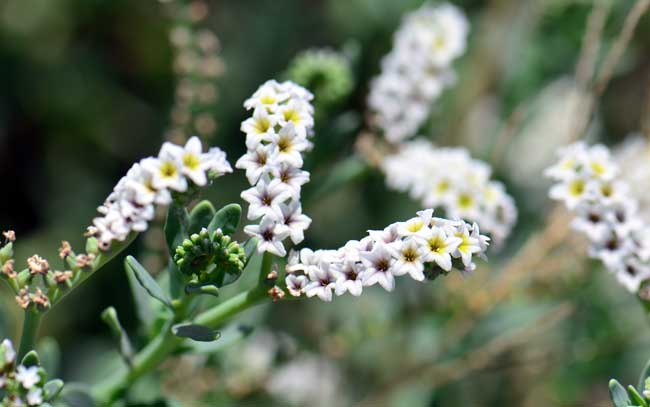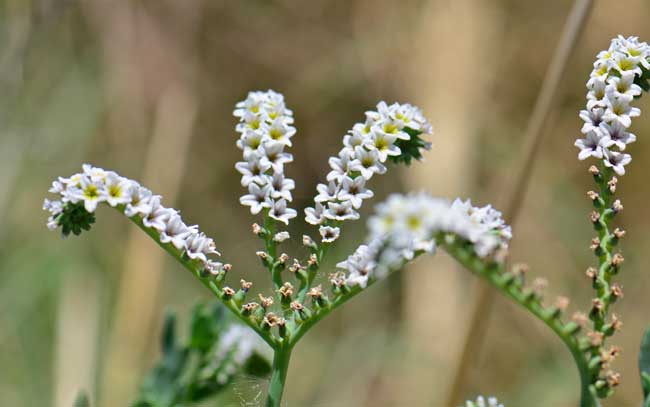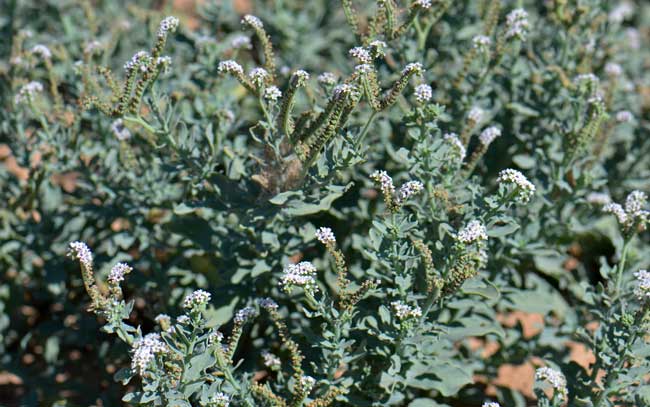Heliotropium curassavicum, Salt Heliotrope



Scientific Name: Heliotropium curassavicum
Common Name: Salt Heliotrope
Also Called: Alkali Heliotrope, Chinese-pulsey (Parsley), Heliotrope, Quail Plant, Salt Heliotrope, Seaside Heliotrope; (Spanish: Rabo de Mico, Hierba del Sapo)
Family: Boraginaceae, Forget-Me-Not Family
Synonyms: ()
Status: Native.
Duration: Annual or perennial.
Size: Up to 20 inches, usually much smaller.
Growth Form: Forb/herb; erect or spreading, weak stems, stems fleshy, glabrous.
Leaves: Gray-green or bluish-green; mostly oval or oblanceolate, short petioles or sub-sessile.
Flower Color: White turning pale purple or yellow in the corolla throat; flowers small ¼ inch with 5 rounded lobes, bell-shaped, inflorescence spikes 2 to 4, scorpioid (like a scorpions upward-curled tail), fruit is a smooth nutlet.
Flowering Season: March to November or may flower throughout the year.
Elevation: Up to 5,000 feet.
Habitat Preferences: Salty alkaline soils, sandy soils, streams and in or near moist areas.
Recorded Range: Salt Heliotrope is found throughout most of the United States and in Alberta, Saskatchewan and Manitoba Canada It can also be found in Mexico and South America.
North America & US County Distribution Map for Heliotropium curassavicum.
U.S. Weed Information: No data available.
Invasive/Noxious Weed Information: No data available.
Wetland Indicator: Heliotropium curassavicum is included on the USDA 2012 National Wetland Plant List as an Obligate Wetland species (OBL), a Facultative Wetland species (FACW), a Facultative species (FAC), and as a Facultative Upland species (FACU).
OBL: Almost always occur in wetlands
FACW: Usually occur in wetlands, but may occur in non-wetlands
FAC: Occur in wetlands and non-wetlands
FACU: Usually occur in non-wetlands, but may occur in wetlands.
Threatened/Endangered Information: No data available.
Genus Information: 28 species in Heliotropium throughout the United States and Alberta, Saskatchewan and Manitoba Canada. Genus also found in Baja California, Mexico and Central and South America.
3 varieties in Heliotropium curassavicum:
Heliotropium curassavicum var. curassavicum, Salt Heliotrope, (AZ);
Heliotropium curassavicum var. oculatum, Seaside Heliotrope, (AZ); and
Heliotropium curassavicum var. obovatum, Seaside Heliotrope.
Comments: Salt Heliotrope is also called Quail Bush because the birds feed on its seeds. The Spanish name Cola de Mico translates to "monkey tail" in reference to its curled or scorpioid flower coils. Ornamental uses include uses in rock gardens, rocky hillsides and desert landscaping.
Salt Heliotrope has several ethno-botanical uses identified at Native American Ethnobotany, University of Michigan, Dearborn.

